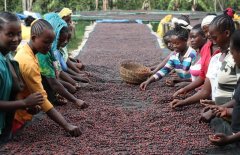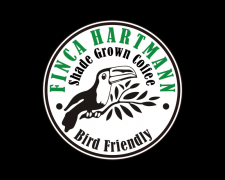Differences in flavor and taste of coffee stories from single producing areas in Ethiopia's best coffee bean producing areas
Until 1995, Ethiopia was divided into provinces. The country is now divided into districts, but the provincial name is still often used to indicate location. The southernmost province of Sidamo (or Sidama) is home to many coffee-growing areas.
There is the beloved Yirgacheffe in the Sidamo area, a small town where nearby farms have always produced some of the best coffee in the world. Many manufacturers in this part of Ethiopia prefer wet processing. This produces a bright coffee with high acidity, light body and sweet fruity and floral aromas.

Another wonderful area is Guji. Gucci Coffee is located in the south of Sidamo region, and some of the best roasters in the world are looking for coffee from Gucci. In the cup, you can look forward to sweet floral aromas, such as jasmine and melons and peaches, as well as tea-like wine.
Harald is located in eastern Ethiopia, just east of the capital Addis Ababa. Almost only dry coffee is produced in this area. These coffees will have an alcoholic taste, have the characteristics of wild fruits, and have a syrup-like body. Confusingly, some Harrar (or Harar) coffee is labeled Mocha Harrar, named after the Red Sea port, where some of the world's best coffee (including coffee from Yemen) is traditionally shipped.
Ethiopia is famous for its coffee beans. However, since Ethiopia grows all the different types of coffee, it can be a bit confusing to talk to someone about the differences between their latest cup of coffee and single-origin Sidamo, Yirgacheffe or even Harrar coffee. Ethiopian coffee has different coffee producing areas, each with its own unique flavor and harvest techniques. Ethiopia also has a traditional way of brewing coffee, which is unique to the country. Ethiopian coffee grows mainly in the southern mountains, up to 8858 feet above sea level, and has deep and fertile volcanic soil. Compared with coffee from low altitude, this kind of coffee tends to have higher quality and more complex flavor. As the coffee producing areas in Ethiopia vary widely and the flavor characteristics vary from region to region there are significant differences among different micro-regions and even among farms.

Sidamo (Sidamo)
The Sidamo or Sidama region, located in the fertile highlands south of Lake Awasa in the East African Rift Valley, is one of the highest coffee-producing areas in Ethiopia.
The area is between 1400 and 2200 meters above sea level, with abundant rainfall and suitable temperature, providing excellent climatic conditions for growing coffee. Along with Harrar and Yirgacheffe, Sidamo is one of the three trademark coffee producing areas in Ethiopia.
The Sidamo area is the hometown of sun-tanned and washed coffee, with a wide variety of coffee flavors. High-quality wet-processed Sidamo coffee is famous for its mellow, low acidity, fruit sweetness and full aroma. Thousands of bags marked "Sidamo" are sold every year, but the quality of the cups may vary significantly. Mercanta evaluates many samples of Sidamo before we make any purchases. We are looking for a coffee with vibrant and refreshing acidity, delicate sweetness, floral and citrus flavors and an elegant finish.
Yega Xuefei (Yirgacheffe)
Yegashafi, one of the subregions bordering Sidamo and the East African Rift Valley, is a mini-area itself, which has been registered as a trademark by the Government of Ethiopia. This steep green zone is both fertile and towering-most coffee grows at or above 2000 meters. The Yejashafi region is famous for its wet-processed coffee, which has a strong aroma, delicate acidity and rich flavor. The mountains of Yejassefi are heavily forested, but in fact it is a densely populated area, dotted with many houses and villages and planted with "garden coffee". There are about 26 cooperatives in the area, representing about 43794 farmers and about 62004 hectares of garden coffee. The product is mainly washed, although Yega Xuefei also has a small amount of dry coffee.
Top Yega Chuefei has a fresh taste and bright acidity, accompanied by complex floral and citrus notes, such as jasmine and lemon grass. Its flavor is similar to Panamanian geisha coffee. Connoisseurs consider Yega Sheffield to be one of the best Arabica coffee in the world.
Harald (Harrar)
Harrar coffee comes from wild native trees on small farms in eastern Ethiopia. This is the highest acreage in the country and produces some of the highest quality coffee beans. Almost all coffee produced in this area is sun-treated.
Harrar coffee beans are harvested and processed almost entirely by hand. The shells of these coffee beans are used to make Ethiopian tea, called hasher-qahwa.
Harrar flavors range from lots of blueberries to a variety of flavors, including bananas, strawberries and bubblegum-some even mint! These coffees are usually full-bodied and full-bodied.
The alcoholic smell of this coffee means that it is usually not suitable for drinking as a single source of coffee. As a result, Harrar is most commonly used to mix espresso to give off an intoxicating fruity flavor. It can change a lot during preparation, so it is difficult to bake evenly. All parts of the unique charm and attraction of this coffee!
Jinbi (Gimbi)
The Gimbi region, located in the western part of the country, is 5570-7210 feet above sea level and is famous for its wet processing of coffee. The varieties grown by Gimbi are full-bodied, moderately acidity, delicate and fruity. Gimbi coffee is an important part of many roasters' blended coffee, although they can also be delicious single-source coffee.
Limu (Limu)
Limu coffee grows in southwestern Ethiopia, between 3600 and 6200 feet above sea level. It is considered to be a kind of high-quality and delicious washed coffee with a balanced body and low acidity. They are full-bodied, with vibrant sweetness and fruit, with a hint of spice.
Gemma (Jimma)
The Jimma or Djimmah region of southwestern Ethiopia is a large producer of commercial-grade coffee. Coffee in this area is best washed because it produces an unpleasant smell when processed naturally.
GHIMBI LEKEMPTI
Around 20% of the famous coffee producing areas, coffee roasters can choose to use one or both. Lekempti is the capital of the area, but the coffee beans of this name do come from the city of ghimbi, which is 100km away, at an altitude of about 1500-2100 meters, and most of the coffee is native.
Important Notice :
前街咖啡 FrontStreet Coffee has moved to new addredd:
FrontStreet Coffee Address: 315,Donghua East Road,GuangZhou
Tel:020 38364473
- Prev

Panama washed Rosa Coffee Bean Flavor the planting advantage of Hartman Manor Coffee Bean in Balu volcanic area
Hartman Manor is located in the Balu volcanic area, the soil is rich in nutrients of volcanic soil, towering original trees become the best shade planting environment, shade planting coffee grows slowly, can brew higher sweetness and brighter acidity. The alpine microclimate of Chiriqui Volcan has also become the perfect base for Hartmann coffee.
- Next

Century-old legendary Hartman Manor Bird friendly Certification Red Wine treatment how do coffee beans taste good?
Hartman Coffee in harmony with the environment Coffee growing Finca Hartmann is a third-generation family business located in Santa Clara in Renasimiento. It consists of two farms, Santa Clara Finca Hartmann and Ojo de Agua, located between 1.300 and 2.000 meters above sea level, with nearly 100 hectares of forest reserves and Parque Nacional de L.
Related
- Detailed explanation of Jadeite planting Land in Panamanian Jadeite Manor introduction to the grading system of Jadeite competitive bidding, Red bid, Green bid and Rose Summer
- Story of Coffee planting in Brenka region of Costa Rica Stonehenge Manor anaerobic heavy honey treatment of flavor mouth
- What's on the barrel of Blue Mountain Coffee beans?
- Can American coffee also pull flowers? How to use hot American style to pull out a good-looking pattern?
- Can you make a cold extract with coffee beans? What is the right proportion for cold-extracted coffee formula?
- Indonesian PWN Gold Mandrine Coffee Origin Features Flavor How to Chong? Mandolin coffee is American.
- A brief introduction to the flavor characteristics of Brazilian yellow bourbon coffee beans
- What is the effect of different water quality on the flavor of cold-extracted coffee? What kind of water is best for brewing coffee?
- Why do you think of Rose Summer whenever you mention Panamanian coffee?
- Introduction to the characteristics of authentic blue mountain coffee bean producing areas? What is the CIB Coffee Authority in Jamaica?

